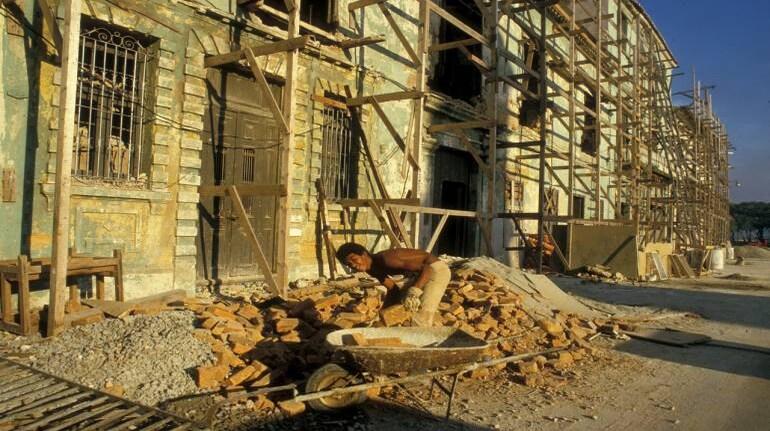Haryana: Jhajjar District Collector’s Cheating Inquiry into Tata Realty Project Remains Stalled After 58 Months

Representational Image. Image Courtesy: Reuters
4 March 2021, Bengaluru: One of the key issues being agitated by protestors led by farmer unions at the borders of New Delhi concerns a provision in the Central government’s new farm laws that allows disputes over farming contracts to be adjudicated only by the government bureaucracy, with no provision to approach the courts.
An example of what a bureaucratic inquiry can look like is provided by the case of the “New Haven” apartment complex in Bahadurgarh, Haryana. The “affordable housing” project, built by the Tata Group company Tata Value Homes (that has since been merged with another Tata group company Tata Realty and Infrastructure) has been facing an inquiry by the district administration of Bahadurgarh’s Jhajjar district for nearly five years now. As NewsClick has covered previously, the company has been alleged to have cheated its customers by inflating the area of the apartments being sold to them. Nityanand Sinha, an Engineer who was directly involved in the project blew the whistle on the alleged cheating in 2015.
Sinha’s complaint alleging cheating was filed against HL Promoters Private Limited, a subsidiary of Tata Value Homes on 7 March 2016, after he had tried and failed to escalate the issue within the Tata group, that employed him as the project head for the New Haven project. Sinha’s complaint included records and internal communications of the company as evidence of the alleged cheating.
In his complaint, Sinha alleged that the company had inflated the “saleable area” of the apartments from the genuine area calculated by architects. In previous articles for Economic and Political Weekly, and NewsClick, the present author has covered in close detail the specific allegation made by Sinha and the sequence of events leading up to his filing a complaint to the state government authorities.
In his original complaint, Sinha had alleged that the company had inflated the Saleable Area of the apartments by declaring a loading factor much higher than that calculated by the project’s architects from plans approved by Haryana’s Town and Country Planning Department. As per documentation of the inquiry proceedings that Newsclick has reviewed, in December 2017, Sinha added the following claim to his complaint that was proceeding before the Deputy Commissioner of Jhajjar: “the area of balcony has been included in the carpet area calculation which can not be calculated in the carpet area.”
In Real Estate jargon “Saleable Area” of an apartment, that determines its cost, includes the “carpet area” that is a measure of the actual area of the apartment, and a “loading factor” that is supposed to represent each home-buyers’ share of the common built up areas in the project including stairs, lift well, corridor, lobby etc. While Sinha’s original allegation had been that the company had inflated the Saleable area by setting the “loading factor” higher than what had been calculated by the project’s architects, his additional allegation was that the company had sought to inflate the carpet area as well.
In a subsequent filing to the Deputy Commissioner, Jhajjar, Sinha clarifies why this allegation of including the balcony in the carpet area is significant. The National Building Code of India, 2005, defines carpet area as “the covered area of the usable rooms at any floor level (excluding the area of the wall).” Since a balcony is not a room, it can not be included in the carpet area. Essentially, Sinha alleged to the inquiry officer, the company was trying every available option to inflate the area it was claiming to sell to customers beyond what it was allowed to.
In the inquiry, the Tata group company was asked to submit its area calculations. These were filed by the company in February 2017. A rejoinder filed by Sinha claims that these submissions showed proof of his cheating allegation.
The rejoinder includes the following table (see attached file) [table to be attached here is in the pdf file titled “loading factor data”]. It compares the figures in the company’s submission to the inquiry in February 2017 with the figures the complainant had received internally in April 2015 while working on the project, which he had attached to his complaint. Sinha claims in his rejoinder that comparing the figures in the company’s submission to Haryana Government inquiry with the figures in its internal documents that he had attached to his complaint shows proof of the alleged cheating. The data of April 2015 was a document signed by the General Manager-Design Coordination of company for use by a consultant company working on the project. While his complaint was that the company had arbitrarily fixed the loading factor at a higher value than the actual calculations, in his rejoinder he says, the data submitted by the company for the inquiry had attempted to adjust its calculations to show that the increase in the loading factor was legitimate. Five items in the common areas that were part of the loading factor calculations – top terrace projection, overall terrace, entrance porch pergola, DG and substation, and landscape features – that had originally not been included by the company in calculating the loading area, were now included in the calculation, incorrectly, Sinha argued. Additionally, 50 percent of the area of another item - ground floor area stilts – that had been correctly included in the April 2015 calculation of the loading factor, was increased to 100 percent in the 2017 submission to the inquiry. This resulted into total loading area arbitrarily going up from 32.22% (1.3222) to 40.05% (1.4005).
Sinha claimed that these items were originally not a part of the loading calculation as the cost of building them had already been included in the base sale rate of Rs. 4000 per square feet that the developer was offering to homebuyers. Including them in the loading factor as well would constitute “double dipping” according to his rejoinder. His claim was that in order to show that the higher loading factor is legitimate, the company was now including them in its data submitted to the inquiry.
Another claim in the rejoinder serves as additional evidence that the loading factor was changed by the company from the value calculated based on the government approved plans. In the two sets of area calculations that Sinha received, that he had attached to his original complaint, the carpet area had changed been recalculated slightly, with a small increase. However, the loading area had disproportionately been increased, because of the alleged arbitrary and unapproved increase in the loading factor.
In the inquiry proceedings, according to documents seen by NewsClick, the company filed its reply on 15 November 2019, after an extended delay. In its reply, the company did not respond to the allegations that had been made against it. Instead, the developer raised questions against the inquiry itself – stating that the complainant (Sinha) was not a customer, that the company had filed multiple defamation cases against him in Gurgaon and Mumbai, and that the matter was outside the jurisdiction of the inquiry official.
Over 58 months since the original complaint was taken up for inquiry by the district authorities, the matter is yet to be completed.
The author sent questionnaires by email to representatives of the Tata Group seeking their response to these allegations on 26 February. Questionnaires seeking comments were also sent to the Jhajjar district collector and to the Haryana Real Estate Regulatory Authority. No responses were received at the time of publication. This article will be updated to include any responses that are received.
The author is an independent journalist based in Bengaluru
Get the latest reports & analysis with people's perspective on Protests, movements & deep analytical videos, discussions of the current affairs in your Telegram app. Subscribe to NewsClick's Telegram channel & get Real-Time updates on stories, as they get published on our website.
























